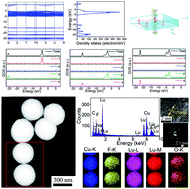Band structure, shape controllable synthesis and luminescence properties of the precursor and final product Lu6O5F8:Eu/Tb/Ce/Dy nano/microstructures†
Abstract
In the present paper, the band structure and density of states of Lu6O5F8 were primarily studied with the help of first-principles calculations, and the indirect band gap of Lu6O5F8 is estimated to be 4.13 eV wide. Lu(OH)1.57F1.43/NH4Lu2F7/Lu6O5F8 nano/microcrystals with diverse morphologies, sizes and dimensions have been synthesized via a mild and controllable hydrothermal process using citric acid trisodium salt dehydrate (Cit3−), hexadecyltrimethylammonium bromide (CTAB), ethylenediaminetetraacetic acid (EDTA), ethylenediaminetetraacetic acid disodium salt (EDTA2−), sodium dodecyl benzene sulfonate (SDBS), ethylenediamine (EA) or polyvinylpyrrolidone (PVP), etc. as an additive, respectively. The phases, morphologies, sizes, and luminescence properties of the as-prepared samples were well characterized by means of X-ray diffraction (XRD), scanning electron microscopy (SEM), transmission electron microscopy (TEM), photoluminescence (PL) and cathodoluminescence (CL) spectroscopy, respectively. The results indicate that the phase, morphology, and size of Lu(OH)1.57F1.43/Lu6O5F8 can be tuned in a controlled manner by altering the amount or kinds of additives, the pH values of the initial solution, and the reaction time. Furthermore, the time-dependent morphology evolution shows that the resulting microrods, hexagonal prisms, flower clusters and spheres were synthesized by a dissolution–reconstruction formation mechanism. It is expected that the synthetic strategy can be extended to controllable synthesis of other types of nano/microcrystals as well. Upon ultraviolet (UV), vacuum ultraviolet (VUV) and electron beam excitation, the luminescence properties as well as the emission mechanisms of the Ln3+ (Ln = Eu/Tb/Ce/Dy) single doped precursor (NH4Lu2F7, Lu(OH)1.57F1.43) and final product (Lu6O5F8) are all compared and studied. All in all, the multifunctional Ln3+ doped NH4Lu2F7/Lu(OH)1.57F1.43/Lu6O5F8 nano/microcrystals have potential applications in photoluminescence areas and field emission display devices.


 Please wait while we load your content...
Please wait while we load your content...